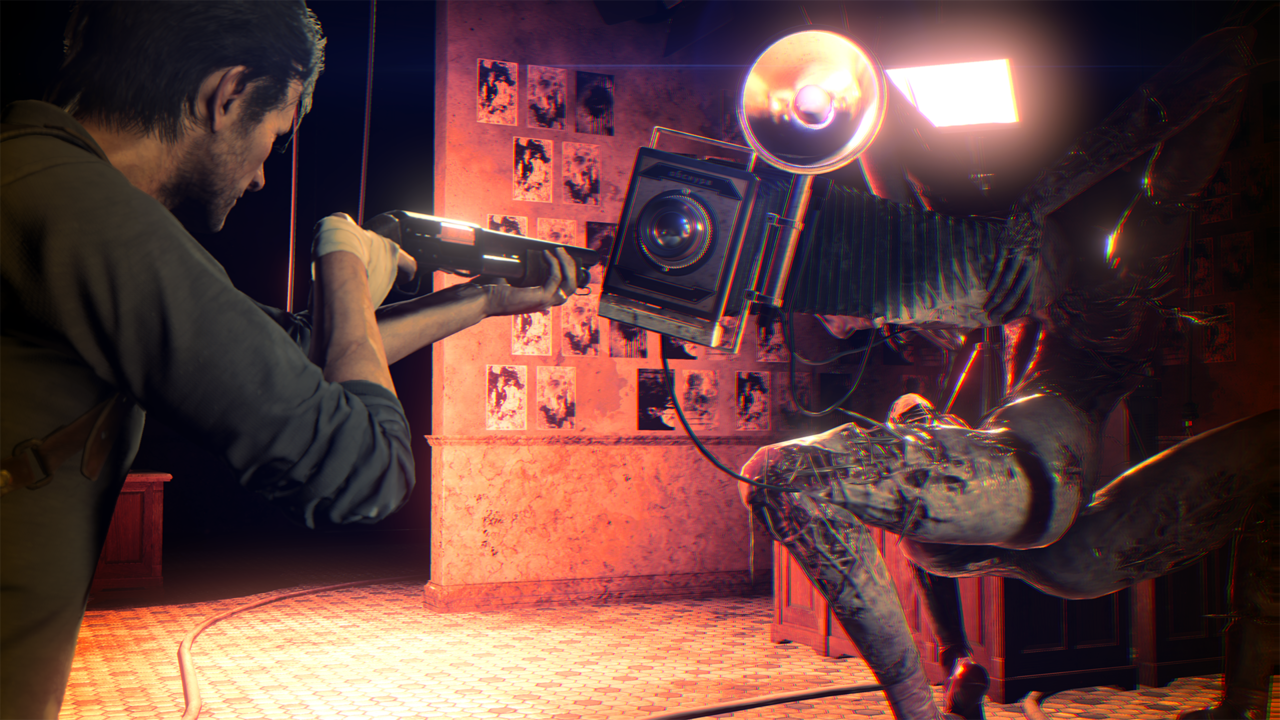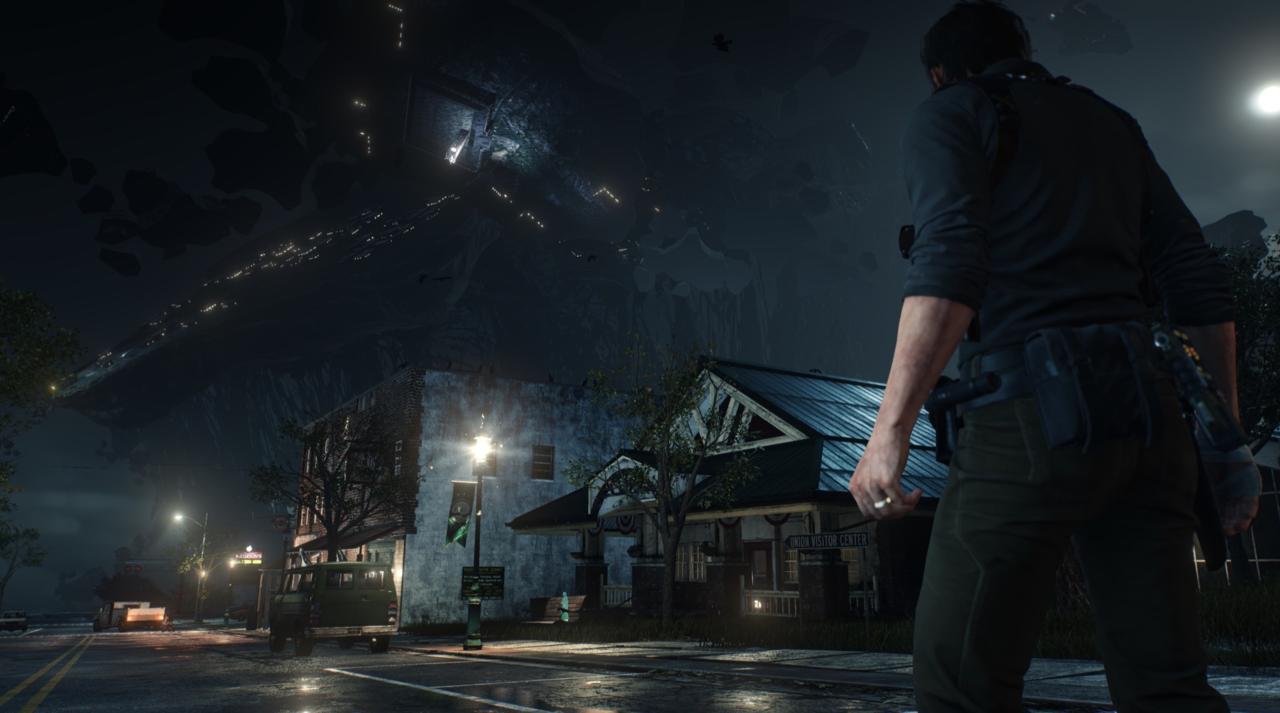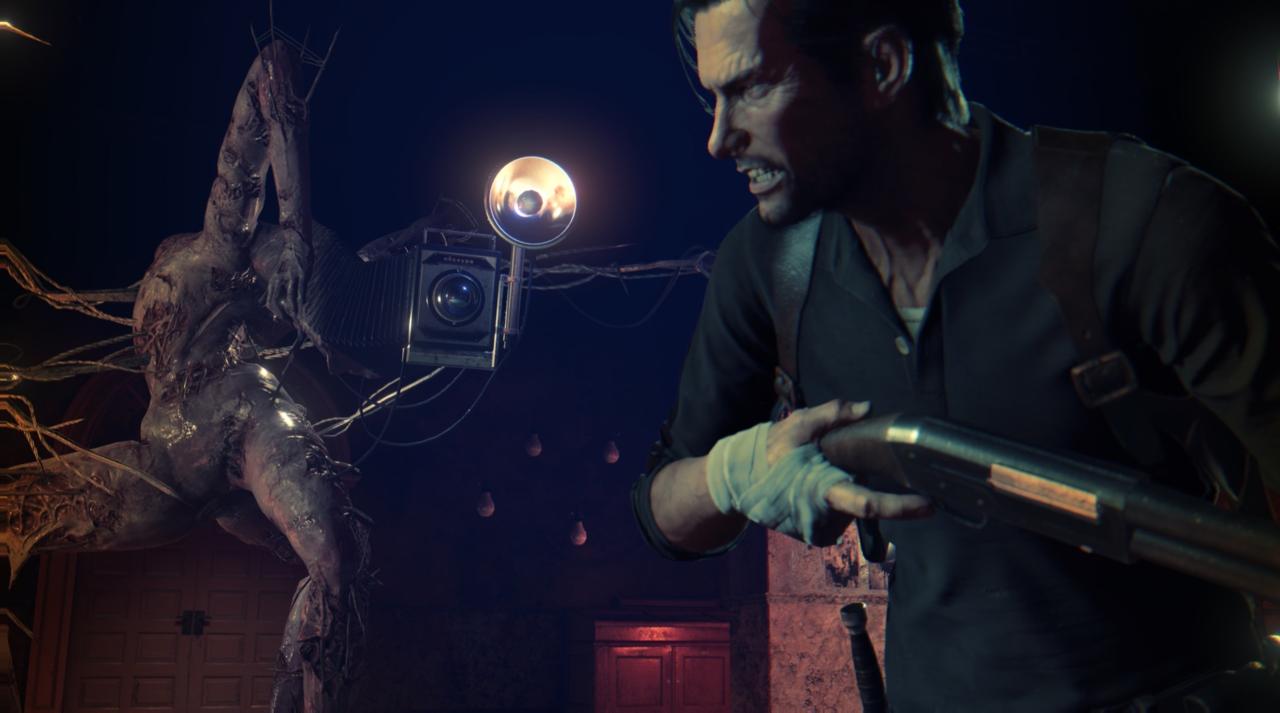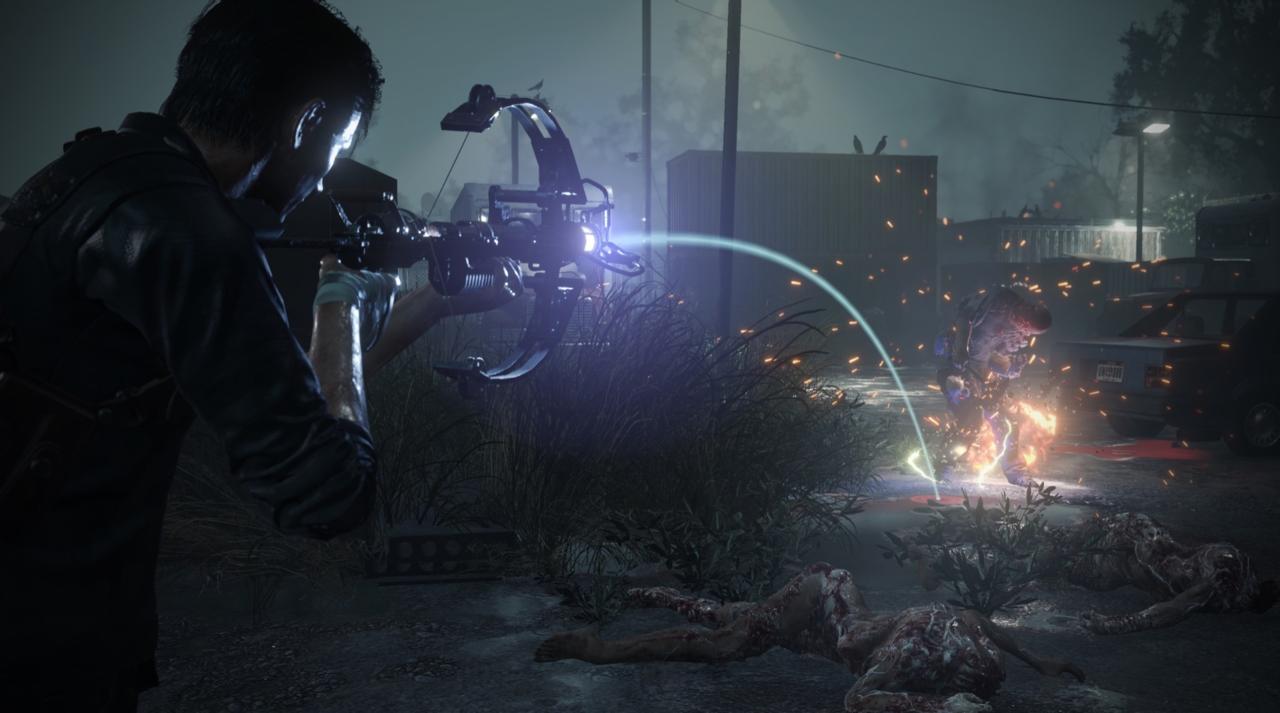Back in June, Bethesda revealed The Evil Within 2, with Shinji Mikami and his studio Tango Gameworks working on the follow-up to their bizarre and mind-bending Survival Horror game. Set for release on October 13, we recently spent some time with it at both GamesCom and QuakeCon, and got to see just what the team has in-mind for Sebastian's second go around in a world of nightmares and dreamscapes--and we came away feeling pretty positive about what's coming up.
During QuakeCon, GameSpot also had the chance to chat with the creative team behind The Evil Within 2, including game director John Johanas (previously worked on the Kidman DLC missions for the original game), lead writer Trent Haaga, whose past work includes several horror-comedy and indie-thrillers such as 68 Kill and Dead Girl--and of course, one of the early pioneers of the Survival Horror genre and creator of the Resident Evil series, Shinji Mikami. While taking a more advisory role as Studio Director, Mikami was pleased with how the game turned out with the new creative leads. Our talk covered the ambitious changes coming to The Evil Within 2, and the current state of the Survival Horror genre.

GameSpot: In the first Evil Within, we saw a number of surprising and interesting locations throughout. Since the setting is largely within the minds of the characters, you're going through a variety different areas that shouldn't really work together, but do because of the bizarre concept and the flow of the narrative. With the sequel, people are more likely to know what they're getting into. What's the challenge in trying to keep things interesting for players this time around?
Shinji Mikami: One of the most unique things about The Evil Within is that you're always in someone else's mind, and getting to experience that world. While the space looks visually real, it is not real. Reality is much more of a strange concept in the game. So we have to make sure players are enjoying the game and the story is focused on Sebastian's goals. In order to rescue his daughter, while at the same time giving him opportunities to explore areas that can help him in his mission, which would drive the player to keep on moving forward.
Trent Haaga: But in any great sequel, it's always important to amp it up. Like in the first game, you were in the mind of a killer, but for this game, it's a bit different. It's not really much of a secret, but there might be more than one antagonist, that's all we can say. The idea is that once you think you've gotten things figured out, things are likely gonna shift around in a completely different direction that is unpredictable. And that's the key to keeping things interesting for a sequel like this.
John Johanas: I think from a gameplay perspective, it's always important to not stay too long in a single location. Not that it gets boring, but you tend to get numb to the situations you're in. We try to think about how we pace it out and give people fresh experiences, then flip things around. You think you're used to something, and you just flip it around and take them to a place they'd least expect.
What's interesting about The Evil Within 2 is that it takes on more open-ended environments, and gives players the means to explore their surroundings a bit. What was the thought process behind that?
John Johanas: So it's basically an advancement of the things we had done in the first game. The original had some larger maps that laid out some tools for you to take advantage of, and we very much wanted to take that further in this game. So we created these maps in the game that are very large and encourage that exploration aspect. And we paired it with resource gathering systems and side-objectives, to really take things at your own pace. We really wanted to separate ourselves from how the first game was presented, which felt like non-stop pressure and tension--we really wanted to alleviate that with more downtime and exploration.

Exploration can be tricky in a Survival Horror game, as going off the beaten path can lead to death or a significant loss in resources. Can you talk about the changes that make the sequel's approach to player progression so different from the original?
Shinji Mikami: In the previous game, it was like sort of this one-way street. You're pushed to go through forward and you had to keep moving on. But in this one, we tried to create more open maps and stages, the world is there, you can explore it, and you see a variety of different scenes. There's a higher degree of freedom here in this game, and we very much wanted it to be that way here. In the first game, it was heavily action-oriented. But for this one, we wanted to accentuate more of those adventure elements.
John Johanas: The original Survival Horror games also had those focuses on exploration and adventure, but the gameplay of it was about overcoming challenges, almost through a brute force method. Like in Resident Evil, there was always a way to get through enemies. Though you were always at a disadvantage, there was always a way to get through it. But as the genre went forward, you also have games that take that away, which are more pure horror titles, where you can't take out the enemies. But The Evil Within always goes back to those methods where you can figure out a way to take out these enemies. Even though we go about it with a wider array of methods, whether through sneak or more aggressive ways, we always want to give players options.
What I liked during my time with The Evil Within 2 was that there were these houses in the small town that had these unique and optional moments associated with them. Like you're learning about the specific horrors that happened there, and seeing what remains of that. Can you talk about the challenges of trying to get players to be more adventurous in an already perilous situation? And was it hard to strike a balance between getting players curious about locations, while also trying to keep them scared and tense?
Shinji Mikami: So basically, the design of our game this time is like a "theme-park ghost mansion" or a haunted house. And in order to keep up the level of tension for the players, we made sure that all the enemies and adversaries are placed in certain locations that can really frighten our players in interesting ways. We're always focused on keeping up the momentum overall. However, if you give only horrific scenes one after the other, the player may pee out of fear. To avoid that, we have places where they can feel safe and secure, to take a break. We did our best to mix it up considerably. So going through all these horrifying moments, and meeting these challenges, you'll find more tools and gear, also a cup a coffee [Coffee makers in The Evil Within 2 restore Sebastian's health].
John Johanas: If there's enough coffee, then you can probably survive this. But really, it's all about risk and reward. The early concept for this was just the idea of "hey, let's give you a gun, five bullets, a knife, and place you in a big map". There was that feeling that you're severely unprepared for that, but you feel the need to search for supplies and items. So there's always that risk, especially with all the enemies hiding out in the area. They can come and find you while exploring, so we wanted to keep this level of tension while you're searching crevices to take the risk.
"if you give only horrific scenes one after the other, the player may pee out of fear."
What was it like of coming into this project? Can you talk about what you were able to do with these established characters and existing space, and how you put your own spin on it?
Trent Haaga: Absolutely, it was a great opportunity to be a part of the game this time around. I have to confess, I'm not much of a gamer, I'm a filmmaker. And I tend to look at things in a way that's more about the characters and the dialog--like where are they emotionally at this point, type space. When I think of Sebastian, I never really think of him as me, he's not me and he's not the player, it's a guy that I still look at as a passive moviemaker perspective. Like when we give Sebastian a moment of breathing room here, let him have a moment to talk about this event, or talk with other characters. Sebastian has a lot to do emotionally in this game than in the first. In the first game, he felt a little lost--simultaneously with the player--while trying to figure out what to do and how to accomplish his goals. But in this game, he enters into it willingly, and therefore, he's got more of an emotional arc this time around.
What's interesting is that you have a background with films from Troma Entertainment [The Toxic Avenger film series, Tromeo and Juliet, and Cannibal! The Musical]. While those movies are known for their ridiculously gory and cartoonish violence, they're still oddly endearing and have some rather touching emotional moments. Is that something you tried to apply here for The Evil Within 2?
Trent Haaga: Honestly, I try to bring that mentality to every project I work on. To varying degrees of success, all depending on the support teams in place. These guys here all created the creatures, the gameplay, the core story, the overarching types of things. So it's my job as a writer to kind of come in and do exactly that, to give Sebastian and the other characters a bit of pathos, to give him a bit gravitas--even give him a bit of levity sometimes. He was a little bit of a blank slate the first time around, and we really had to get him to find his voice here. He was really kind of a "oh crap, damn, watch out!" kind of guy in the first game. We had a larger canvas to work with here, and we also have a larger cast of characters here with their own voices and needs, wants, and desires. I moved to Tokyo and sat in the office working with these guys for months working hand-in-hand, all to make this thing coalesce and gel.

VR has jumped off in a big way, and we're seeing a lot titles take advantage of that. Just at QuakeCon, we got to play Skyrim, Doom, and Fallout using the new technology. Have had any ideas about using VR and are you excited about what's can be done with it?
Shinji Mikami: Since VR is extremely well fit for the horror genre, I am extremely interested in that area.
John Johanas: There's a lot of possibilities for creating unique immersive experiences through it.
Trent Haaga: Man, I hate being the old codger when this question comes up. [Laughs] It's like I don't even have to use my physical imagination anymore. I understand that this is the way it's going, but it's a little weird for me and I think that once we put on these helmets, we dislodge from one another via virtual means. Who knows, right? I don't want to be a doom-sayer, I don't know, it's bad! Of course, I'm supposed to sit here and say "VR is awesome and I can't wait to leave this planet, but I don't." I don't know, can I just read a book in VR instead? It's gonna be crazy, it'll be like I Am Legend one day, with me around a bunch of VR zombies.
Over the years, the concept of what Survival Horror represents seems to have been gradually evolving. While they tended to be more subdued and atmospheric, now there's a big focus on action and big boss battles. Interestingly enough, Resident Evil 7 came out this year and that went back to a more traditional style that the series was known for. What are your opinions on the evolution of Survival Horror, and did you get the chance to play through Resident Evil 7?
Shinji Mikami: As far as the Survival Horror genre goes, it started in the old days with games that did have action-focused elements. Placing you in situations where you have to escape enemies while figuring out ways to overcome him. Those elements are mainstays of the genre to this day. However, we definitely have seen a number of games that are going back to simpler and more pure horror-oriented games. As for Resident Evil 7, I played the VR version of the game, and it was enormously exciting and fun.

Considering that this game was just announced back in June, and now we're gonna be playing it this October, what can you say was the most interesting and fulfilling part of making this game?
Trent Haaga: Just being able to work on a video game was super exciting. Working with non-movie people in a non-movie environment on a project, just being able to help find the voices of iconic, and hopefully more iconic, characters in this game. Certainly Sebastian existed, but just to bring out this guy's voice and to bring him out a bit more and find who he is. In particular, we have this character Stefano, one of the bad guys in there and he's got this great patter, and it was just so much fun to be able to get there and just sit there with the typewriter and you see the design, and there he is--and then you write and hear the voices, and you realize "Oh, I kind of helped three-dimensionalize this character". And that was a lot of fun for me.
John Johanas: I'm really proud of a sequence that happens later in the game that I'm not going to talk about because it's a big spoiler, but other than that--to be honest, just coming to this point and realizing it's coming out in like two months. I grew up just as a fan of games, and just to find myself in this position--game design is really, really hard. There's a lot of struggles, lots of challenges, and a lot of the time you feel that it'll never come together. But to be here, to have people play it--to see that they like it--it's just really nice to see that.
Shinji Mikami: I have to mention two things--for one, our timeline was pressed, a much shorter development period than the first game. We had to build wider stages, and the staff members did tremendous work. To be able to create this, despite all the challenges, was something I'm very proud of. The second, is that it's a horror game, first and foremost, but towards the end of the game, you'll find yourself so moved to tears and you'll cry. So this is a rather new kind of game for us, and I'm very proud of that.











